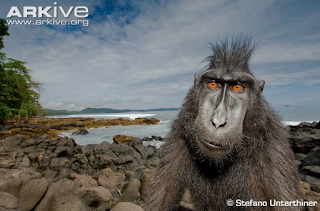Back
to Normal – Whatever that is!
Hi Everyone,
As you know I have returned from Australia, and before I
start putting up all my pictures, and telling you about all the wonderful things
I saw and did there, I thought I’d talk about a very endangered animal that I find very
interesting.
The crested black macaque is critically endangered. Before
we get into the reasons for this monkey’s dilemma, let’s look at some facts. But first his picture:
As you can see from the above picture, this monkey is the
punk-rock star of the macaque species. Identifying them, as a species, has been
a bit hair raising (giggle) due to the fact that they have a short rudimentary
tail. This short tail threw everyone off. At first it was thought that this
monkey was an ape. As you all know, apes have no tails, and monkeys do. Oh, you didn't know that? That’s
the main distinguishing mark between the two! There are a few other characteristics that
distinguish them. One other difference is the length of the arms. Apes’ arms
are longer than their legs. Monkeys’ arms are the same length or shorter than their
legs. As a result of this particular difference, apes can walk upright, and
monkeys move on all fours. Also, apes have larger brains, and can live a great
deal longer than monkeys. Here's a video summary for you. Your children will enjoy this. Time to share!
There are seven species of macaques, and this one is the
most endangered. The crested black macaque lives on the island of Sulawesi,
which is part of Indonesia. They are a very social species, and prior to their decline they formed groups of one hundred individuals or more. That is no longer the case.
For more detailed information on this primate, click on the
following link;
Oh, I almost forgot. Why is it that this very unusual animal
is critically endangered? Well, the main reason is over-hunting, and not by
lions, tigers, and bears, Oh My! This macaque is considered a delicacy in
Sulawesi. What’s more, it is suffering from shrinking habitat. So, not only are
humans eating the animal, they are also spending a lot of effort in clearing
their habitat for agriculture and logging. Since Sulawesi is an island, there
is not much area for them to go to.
“Captive breeding of this species has been successful at
Jersey Zoo and a number of other zoos, and individuals may be reintroduced into
the wild in the future. If this species is to survive, it is essential to
address the problems of hunting and habitat loss on Sulawesi.” (Arkive.org)
Thank you for thinking about this primate, at least for a little while.
J.E. Rogers


Very interesting facts,love finding things that will engage young readers and monkeys and apes are some of the best. Thanks for sharing.
ReplyDeleteThank you so very much for visiting and for your comment. This coming week I will be posting on the Pallas Cat. Hope you can stop by again.
DeleteSincerely,
J.E. Rogers